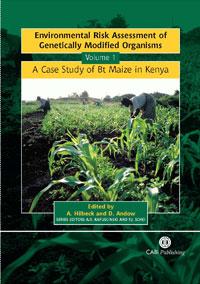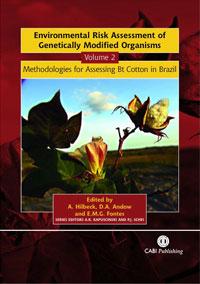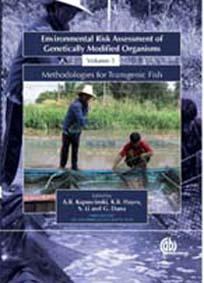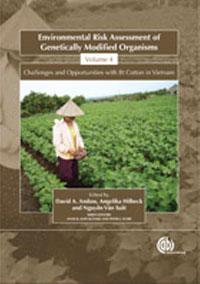Environmental Risk Assessment of Genetically Modified Organisms
Series editors A.R. Kapusinski and P.J. Schei, GEF Scientific and Technical Advisory Panel
Kenya and Brazil books available online through the BCH
The first two project books, the Kenya book and the Brazil book, are now available for free viewing as PDFs. The books are on the Biosafety Information Resource Centre of the CBD’s Biosafety Clearing House. The PDFs can be viewed, but cannot be printed. Thank you to CABI for aiding us in making the books available.
- Link to Vol. 1, A case study of Bt maize in Kenya
- Link to Vol. 2, Methodologies for assessing Bt cotton in Brazil
How to order the books
The books are published by CABI, Wallingford, UK. Copies can be ordered online: Kenya book link, Brazil book link, and Vietnam book link (or go to http://www.cabi.org/bookshop, to Plant Sciences and then to Biotechnology, Plant Breeding and Genetic Resources. Scroll down to find the books).
The first project book was published in 2004:

Volume 1: A Case Study of Bt Maize in Kenya
Edited by A. Hilbeck and D.A. Andow
The Kenya case study book develops transparent and rigorous scientific methodologies for assessing potential environmental risks of Bt maize in Kenya, a treatment that is timely since it preceded the introduction of these GMOs for field testing in the country. A main aim of the GMO ERA Project (previously the GMO Guidelines Project) is to develop risk assessment methods for use in developing countries. Through this case study, the 54 authors, 24 of them scientists from East Africa, illustrate the scientific and logical process by which environmental risk assessment can be conducted. Questions examined include: key risk issues associated with transgene expression and locus structure; how to identify possible hazards to non-target species and biodiversity, and how to consider the likelihood of gene flow and estimate its consequences, and scientifically rigorous laboratory and greenhouse-based methods to investigate these hazards; what is the resistance risk associated with Bt maize in Kenya and how could it be managed?
- CABI Bookshop link
- BCH link (PDF)
The second project book was published in 2006:

Volume 2: Methodologies for Assessing Bt Cotton in Brazil
Edited by A. Hilbeck, D.A. Andow and E. M. Fontes
In this second book, the methodologies have been substantially developed and refined, notably the methodology dealing with impacts on biodiversity and non-target species (Hilbeck et al., Chapter 5) and the following chapters focussing on herbivorous pests, pollinators, predators, parasitoids and soil functions, but also in all the chapters dealing with gene flow and its consequences (Johnston et al., Chapter 11) and resistance management of Bt cotton (Fitt et al., Chapter 12). The available information on transgene expression and locus structure of Bt cotton varieties is examined, and the book includes a detailed background chapter on cotton cultivation in Brazil.
Volume 3 was published by CABI in 2007:

Volume 3: Methodologies for Transgenic Fish
Edited by A.R. Kapuscinski, K.R. Hayes, S. Li and G.V. Dana
This volume, based on a workshop at the WorldFish Center, is the first peer-reviewed effort to synthesize scientific methodologies, combined with stakeholder deliberation, for assessing and managing environmental risks of transgenic fish. The science needed to inform environmental biosafety policy and regulation for transgenic animals in aquaculture is also addressed. Much of the discussion also applies to environmental risk assessment and management of selectively bred or introduced fish species that might escape from aquaculture operations. Each chapter ends with a non-technical summary.
The fourth project book was published by CABI in 2008:

Volume 4: Challenges and Opportunities with Bt Cotton in Vietnam
Edited by D.A. Andow, A. Hilbeck and Nguyen Van Tuat
This volume in the series is part of a larger effort in Vietnam to increase investment in studying the environmental risks of transgenic plants, managing transgenic products safely, and building modern labs to assess their safety. Vietnam plans to introduce GM crops, such as Bt cotton, to benefit agricultural development in the country. This book is the first scientific effort to synthesize information relevant to environmental risk assessment of GM crops in Vietnam, taking Bt cotton as an example. It can be used as a technical manual to enable Vietnamese scientists to evaluate the potential environmental impacts of Bt cotton varieties prior to commercialization, and, with some modification, provides guidance for environmental risk assessment of any transgenic crop.
- Order the book here: CABI Bookshop link
Contents and reference of the books
Hilbeck, A., Andow, D.A. and Van Tuat, Nguyen (eds) (2008) Environmental Risk Assessment of Genetically Modified Organisms Volume 4: Challenges and Opportunities with Bt Cotton in Vietnam. CABI Publishing, Wallingford, UK. ISBN: 9781845933906
Hilbeck, A., Andow, D.A. and Fontes, E.M.G. (eds) (2006) Environmental Risk Assessment of Genetically Modified Organisms Volume 2: Methodologies for Assessing Bt Cotton in Brazil. CABI Publishing, Wallingford, UK. ISBN-10: 1-84593-000-2, ISBN-13: 978-1-84593-000-4
- Check and copy citation reference for each chapter (PDF)
- Download the contents pages (PDF)
- Download a list of authors addresses (PDF)
Hilbeck, A. and Andow, D.A. (eds) (2004) Environmental Risk Assessment of Genetically Modified Organisms Volume 1: A Case Study of Bt Maize in Kenya. CABI Publishing, Wallingford, UK. ISBN 0-85199-861-5